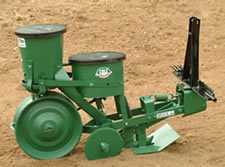Bubbleboy78
New User
Greetings!
I have recently started a pumpkin patch on approximately 2 acres. I am wanting to go with no-till methods to preserve organic material, protect topsoil, and promote cleaner fruit.
I have seeded a rye/vetch cover crop and am now looking ahead to the planting - but what unit to purchase?
I am looking to purchase a one-row planter. I need for it to be reliable, adaptable to multiple seeds (at the very least pumpkin!) , and preferably have a fertilizer hopper onboard.
Here is my issue: crops are not a giant agricultural resource in my area (mainly small hay and cattle operations), so I don't have a large pool of local knowledge to draw from.
So far, I am interested in the Cole MX12 Planter. It seems like it would mostly fit my needs.
However, all images show it on a thoroughly prepared seedbed.

My questions:
Is this a reliable unit?
My understanding is that I can purchase pumpkin seed plates, or modify seed plates for it relatively easily?
Is it possible to mount coulters ahead of the unit, creating the no-till use I desire? I will be planting through a (possibly substantial) cover crop that has been rolled down.
Again, I apologize for my ignorance, this type of equipment is only seen in passing around these parts.
Thanks for your time and advice.
I have recently started a pumpkin patch on approximately 2 acres. I am wanting to go with no-till methods to preserve organic material, protect topsoil, and promote cleaner fruit.
I have seeded a rye/vetch cover crop and am now looking ahead to the planting - but what unit to purchase?
I am looking to purchase a one-row planter. I need for it to be reliable, adaptable to multiple seeds (at the very least pumpkin!) , and preferably have a fertilizer hopper onboard.
Here is my issue: crops are not a giant agricultural resource in my area (mainly small hay and cattle operations), so I don't have a large pool of local knowledge to draw from.
So far, I am interested in the Cole MX12 Planter. It seems like it would mostly fit my needs.
However, all images show it on a thoroughly prepared seedbed.

My questions:
Is this a reliable unit?
My understanding is that I can purchase pumpkin seed plates, or modify seed plates for it relatively easily?
Is it possible to mount coulters ahead of the unit, creating the no-till use I desire? I will be planting through a (possibly substantial) cover crop that has been rolled down.
Again, I apologize for my ignorance, this type of equipment is only seen in passing around these parts.
Thanks for your time and advice.


